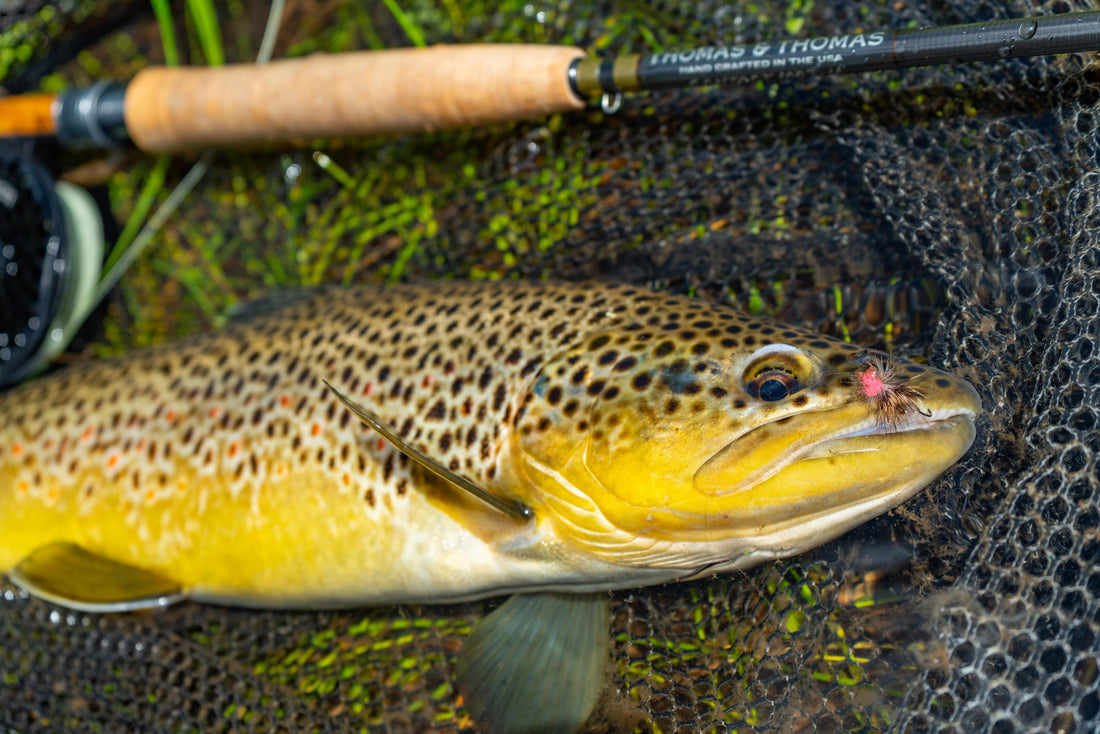
Observations That Lead to Extra Fish and a Welcome to Our New shop Manager
Share
I've had a lot of instances in the last month that have had me thinking about how important small everyday observations are in fly fishing. This is the focus of the biggest chapter in my book Tactical Fly Fishing: Lessons Learned from Competition for All Anglers because making observations and forming a plan based on them is one of the most important behaviors of a successful angler.
Let me mention a few observations which have led to extra fish and or fewer lost flies for me in recent trips.
1. Flashing Fish. In the late summer and fall the sun often shines up the canyons of many of our local east to west flowing streams. It comes in at such an angle in the latter half of the day that brown trout will light up like a gold flashing Christmas light. It also happens that when the water warms (high 50s and low 60s fahrenheit) in the afternoon, and a few small mayflies start to hatch, the fish invade very shallow riffles that are really easy to walk by without fishing. I still catch myself doing this even when prior experience has shown you that fish will often be in this water in the right conditions. However, if you are always paying attention in your peripheral vision you'll see flashes or other strange colors appearing and disappearing under the water that usually signal a fish is there if you trust your instincts. There have been three days recently where 20 or more fish a day have shown themselves in this way often in places where I would not have expected a fish to be. The encouraging thing is that fish which show themselves this way are usually feeding and willing to eat if you make a good presentation. But if you ignore that flash you saw out of the corner of your eye, you may only see that fish again as it streaks away when you wade past it upstream.

Lance Egan fishing some local water. There were lots of fish we both caught that day after locating them from underwater flashes.

The flank of a brown trout from my home river which I caught after watching it flash underwater.
2. Underwater obstructions. Reading the water is more than just looking at the surface and identifying currents with different speeds that might hold trout better than adjacent currents. To truly read the water, you must peer beneath to locate depth changes, fish holding structure, and fly eating snags. One of the most frustrating things that happened while I was still guiding anglers was the avoidable loss of flies. It was a very common occurence for me to say, "do you see that branch at the back of the pocket?" The angler would affirm, "yes I see it." I would then say, "make sure you pull your nymphs out of that pocket before they reach the branch." In the next few casts the angler would hook the branch and I would need to re-rig being two nymphs poorer. This situation is very avoidable for all of us though. Sure there are plenty of snags and obstructions which aren't visible but with even a slight bit of studying the water you're about to fish you can usually see the colors of rocks, logs, etc. that don't match the surrounding water. Fishing around these snags can lead to extra fish which are seeking shelter beneath them. Running your flies into them produces a predictable and annoying situation.
3. Noticing subtle rises. Most of us can spot a nicely ringed rise in flat water fairly easily. However, a lot of times rises a very subtle. Sometimes fish that eat just below the surface don't even create a ring but their behavior forms "nervous water" instead. I once won a lake session during the America Cup tournament almost solely casting to water that had ripples or flat spots which were different than the surrounding slight chop. Each of these instances of "nervous water" were created by fish eating a few inches below the surface. When they turned down their caudal fin pushed enough water upwards to flatten or ripple the surface. Let me share a couple of recent instances as well.
The first instance shows that observations can be auditory as well as visual. Last week I fished a large local reservoir with Dave Hawkes. When we first arrived there were still a few cutthroats rising occasionally. During one of our drifts, I heard what sounded like a quiet flush slightly behind me and to my right side. I quickly turned and saw the remnants of the rings from a rising fish. I ripped in my flies, fired a cast that put the middle of my three fly rig on top of the rise and started a retrieve. Within a few strips I locked into not one but two large cutthroats. Unfortunately one came off during the fight but I still added one more fish to the net which I wouldn't have if my ears weren't attuned to my surroundings as well as my eyes.

The second instance also occurred while I was fishing with Dave a couple of weeks before. We chose to fish a stretch of a remote river that day. It's a piece of water that I've always wondered about but haven't ever visited. I expected a lot of well built browns in the 14-18" category since they are common in similar rivers in the area. We caught good numbers of fish, many of them on dry flies fished above a nymph on a Euro leader. However, most of them were 8-12" with the odd 14-15" brown thrown in when we were lucky.
As we worked up river there was a side channel which held a bunch of these smaller fish. Near the bottom of the channel was a slow moving eddy under the willows which was covered in a mat of foam. Given the old fisherman's adage that "foam is home" I expected a fish to be in the eddy. However, I also expected there to be a bunch of fly eating sticks at the bottom of it and it was a difficult cross to reach the eddy if I snagged my nymph. While I was contemplating whether or not to make a cast, a small hole in the foam appeared and then disappeared. It didn't look like much but I knew it was from a fish, which made my decision easy. I made a quick cast and a snout appeared just as quickly to take my Front End Loader Caddis. I instantly knew this fish was different than the others I had seen that day and after a tense battle on light tippet the biggest fish of the day hit my net. That fish made the trip for me but I might have passed that spot by if I hadn't been closely watching the foam when it rose.

The eddy which held my "fish of the day".
A subtle momentary splitting of the foam in the eddy revealed this fish' position to me.
The moral of these stories is keep your eyes and ears peeled. Observations made in the spur of the moment can lead to memorable fish which keep you excited for the next trip.
In other news, the Tactical Fly Fisher shop has a new manager. I met Connor Murphy in 2010 when he was a sophomore in high school fishing for the Colorado youth team at the America Cup Fly Fishing Tournament. The next year I moved to Fort Collins, where Connor is from, for graduate school at Colorado State University and we became fast fishing friends. Connor and I have shared some of my favorite days on the water together. When you spend 12 days hiking and fishing through the backcountry with a friend and you still want to be around them when you leave you know you've found a good person to fish with. Connor lives and breathes fishing as much as I do and I'm excited to have him aboard to help free up time for me to do things like writing this blog and a new stillwater fly fishing book, which will hopefully be out in a few years.

Tight lines everyone!
Devin
